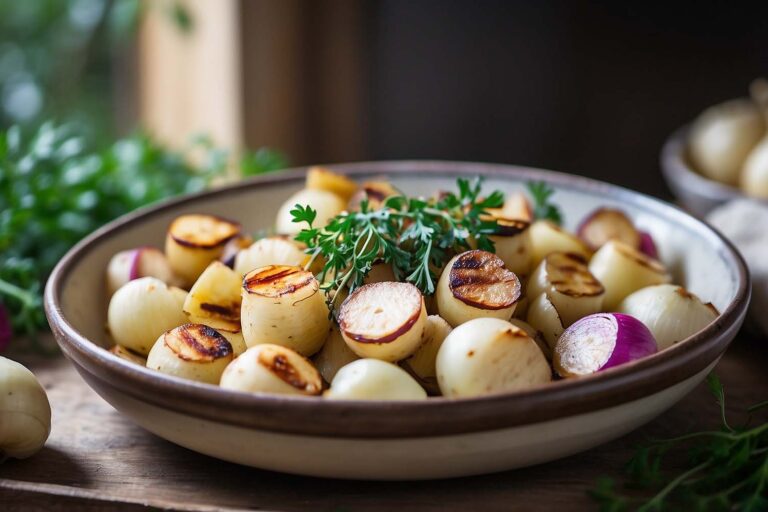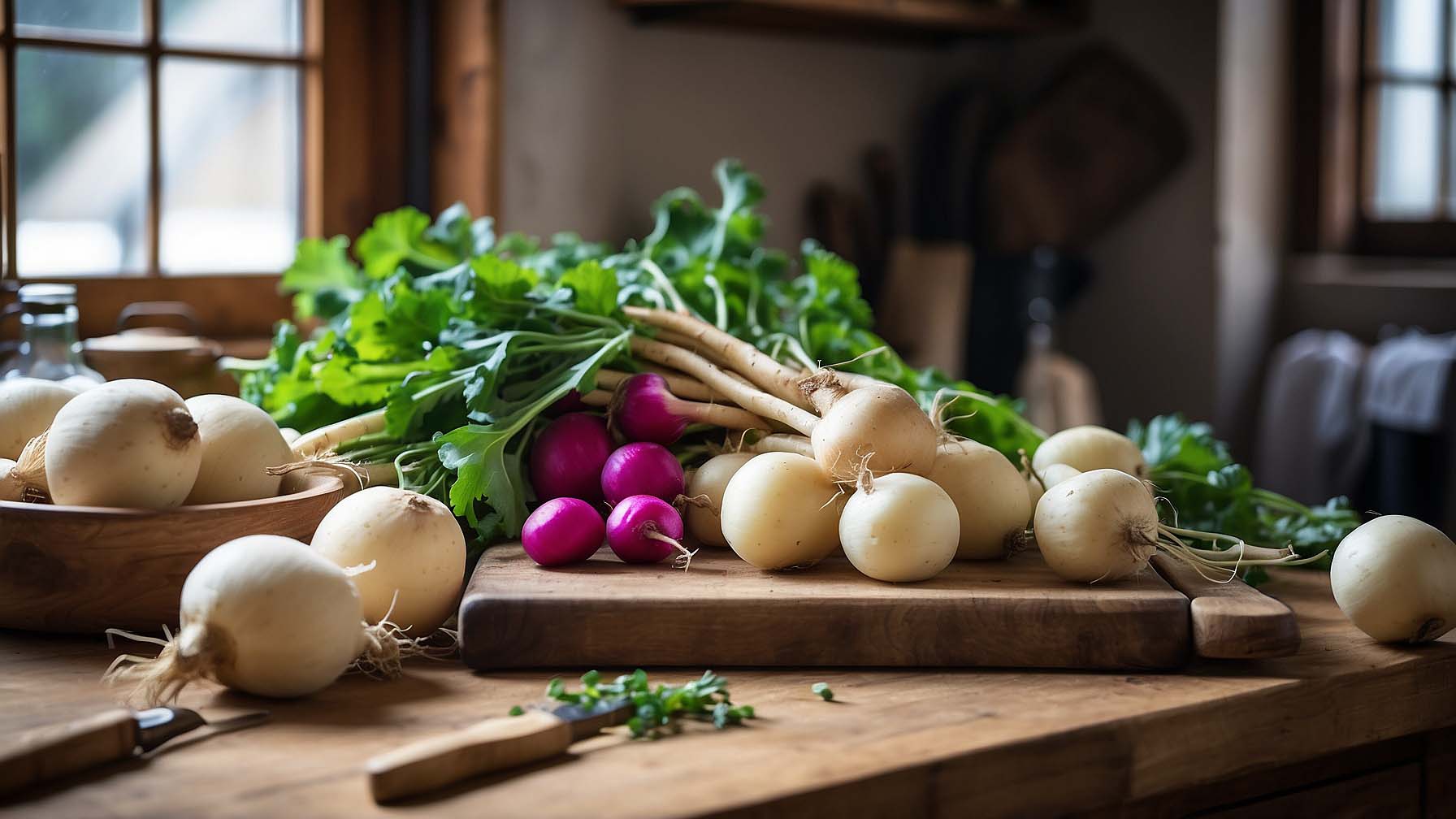Turnips and parsnips are nutrient-rich root vegetables often used in cooking. They both offer distinct flavors and health benefits.
Turnips, with their white-purple hue, are often less sweet than the creamy-white parsnips, yet both are versatile in the kitchen. These roots can be roasted, mashed, or added to stews for a hearty addition to meals. They pack a wealth of vitamins and minerals, including vitamin C, fiber, and potassium, contributing to a balanced diet.
Turnips and Parsnips: Root Vegetables’ Profile

Vegetable aisles may applaud carrots and potatoes. Yet, turnips and parsnips deserve acclaim. These underground gems often fly under the radar. Read on to discover the nutritional treasures and rich history these roots offer.
Nutritional Values and Health Benefits
Turnips and parsnips bring vital nutrients to your plate. They’re packed with vitamins and minerals. Turnips are low in calories but high in vitamin C, aiding your immune system. Parsnips contain fiber, supporting digestion. Both have antioxidants which fight disease.
- Turnips: Low in carbs, rich in fiber, vitamin C, and potassium.
- Parsnips: Good source of fiber, vitamins C and E, and folate.
| Nutrient | Turnip | Parsnip |
|---|---|---|
| Calories | 28 | 75 |
| Fiber | 2.8g | 4.9g |
| Vitamin C | 21mg | 17mg |
Historical Cultivation and Usage
Turnips and parsnips have nourished civilizations for centuries. Romans relied on parsnips as a staple food. Turnips were a mainstay in medieval Europe. They both have adapted to many climates, spreading across the globe. Early turnip harvests from ancient farming to modern gardens reveal their resilience and versatility.
- Turnips were one of the first European crops
- Parsnips were a sweet treat before the cane sugar era
- Both were commonly used to feed livestock
Cultivating and Harvesting
Unearth the secrets to a thriving turnip and parsnip garden in our guide to cultivating and harvesting. These root vegetables, with their earthy flavors and nutritional benefits, deserve a spotlight in any home garden. Let’s delve into achieving a bountiful harvest.Best practices for growing
Best Practices for Growing
- Start with quality seeds from a reputable supplier.
- Ensure proper spacing – about 6 inches apart for ample growth.
- Avoid overwatering to prevent root rot.
- Thin seedlings early to prevent crowding and competition.
- Control weeds with mulch to help retain soil moisture.
- Turnips and parsnips need full sun to flourish.
- Use gentle fertilizers rich in phosphorus for root development.
Optimal Conditions for a Bountiful Yield
| Condition | Requirement |
|---|---|
| Soil Type | Loose and well-draining soil with a pH of 6.0-7.0 |
| Sowing Time | Early spring for summer harvest, late summer for fall harvest |
| Temperature | Cool weather is essential – below 75°F (24°C) |
| Sunlight | At least 6 hours of direct sunlight daily |
| Watering | 1 inch per week, evenly distributed |
Handling and Storage Post-harvest
Harvest your turnips and parsnips with care to prevent bruising. Use a fork to loosen the soil and gently remove the roots. For storage:
- Brush off loose soil. Avoid washing to prevent mold.
- Trim tops to about an inch to reduce moisture loss.
- Store in a cool, humid place. Basements or root cellars are ideal.
- Use perforated plastic bags to maintain humidity.
- Turnips can last up to 4 months, parsnips up to 6 months if stored properly.
Learn more: When to Harvest Purple Top Turnips
Culinary Uses Worldwide
Turnips and parsnips grace tables across the world with their distinct flavors.
Known for their versatility, chefs use these root vegetables in myriad ways.
Traditional Dishes Featuring Turnips and Parsnips
These root vegetables are staples in cuisines globally.
- Neeps and tatties from Scotland pair mashed turnips with potatoes.
- In France, pot-au-feu includes turnips in its hearty broth.
- Nordic countries savor root vegetable mash, combining both turnips and parsnips.
Modern Twists on Classic Recipes
Chefs are getting creative with these traditional veggies.
- Turnip fries are gaining popularity as a healthier alternative to potato fries.
- Parsnip puree adds a sweet twist to classic mashed potatoes.
- Roasted parsnip and turnip salads bring a fresh approach to winter vegetables.
Pairing With Other Ingredients
Turnips and parsnips blend well with a variety of flavors.
| Vegetable | Pairings |
|---|---|
| Turnips | Bacon, apples, spices |
| Parsnips | Maple syrup, nutmeg, carrots |
The Garden-To-Table Movement
The Garden-to-Table Movement taps into the rich tapestry of local produce, highlighting the flavorful and nutritious benefits of eating straight from your own backyard. Turnips and parsnips, those earthy root vegetables often overshadowed by their more mainstream cousins, have found their moment in the sun. By embracing these robust veggies, food enthusiasts and green thumbs alike are reinvigorating a passion for homegrown tastes and community-based eating habits.
Impact on Local Farming
Local farming thrives when more people choose garden-to-table options. Farmers get inspired to cultivate a wider variety, including nutrient-packed turnips and parsnips. This diversification can lead to:
- Better soil health
- Reduced transportation emissions
- Fresher, more flavorful produce
Gardening at home also supports local seed suppliers and encourages the preservation of heirloom turnip and parsnip varieties.
Encouraging Backyard Turnip and Parsnip Gardens
Nurturing backyard turnip and parsnip gardens empowers individuals to contribute to sustainable practices. It’s easy to start a garden, especially with these simple steps:
- Choose a sunny spot
- Prepare the soil with compost
- Sow seeds according to package instructions
Inviting children to help in the garden not only teaches them about where food comes from, but also the values of hard work and patience.
Community Engagement Through Food
Food brings people together, and turnips and parsnips can play a star role in this. Community engagement initiatives might include:
- Garden clubs
- Harvest potluck dinners
- Recipe swaps featuring local produce
These activities foster connections and create opportunities for neighbors to share their gardening tips, turnip and parsnip dishes, and stories.
Future Trends and Research
Exploring the future trends and research in root vegetables shifts our gaze towards an exciting horizon. The agricultural domain constantly evolves, aiming to satisfy the gourmet palate and fortify crop resilience. Let’s dig into the innovative advancements shaping the turnip and parsnip industry.
Breeding for Taste and Resistance
Scientists and farmers work hand in hand, enhancing flavors and strengthening plant defense. Novel breeding techniques focus on creating varieties with superior taste profiles. They prioritize natural resistance against pests and diseases, reducing chemical usage. The goal is twofold: delight the consumers and protect the environment.
Innovative Products and Markets
Exploring uncharted territories, entrepreneurs craft enticing turnip and parsnip products. These include ready-to-cook meals, health-centric snacks, and even plant-based substitutions for animal products. Market demand propels innovation, spotlighting these root veggies on the global stage.
Sustainable Practices and Organic Farming
- Eco-friendly cultivation methods gain traction.
- Farmers opt for organic farming techniques.
- Soil health and biodiversity stand at the forefront.
- Consumers increasingly favor locally grown, organic produce.
As a result, turnips and parsnips are returning to their roots in the most literal sense, promising a greener future for agriculture.
Conclusion
Embracing the versatility of turnips and parsnips can transform your culinary adventures. These root vegetables offer a bounty of nutrients and a plethora of cooking possibilities. Whether roasted, mashed, or stirred into stews, their distinctive flavors elevate any dish. Don’t overlook these hidden gems; instead, make them staples in your kitchen for both health and taste. See all in at Farm Pioneer for knowledge based for Turnips.
